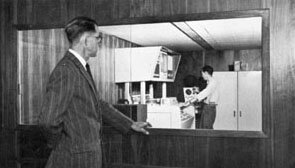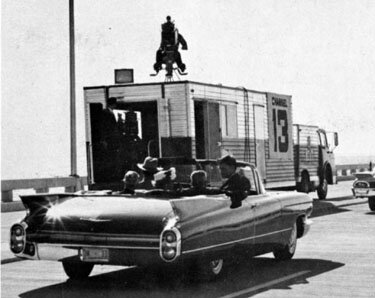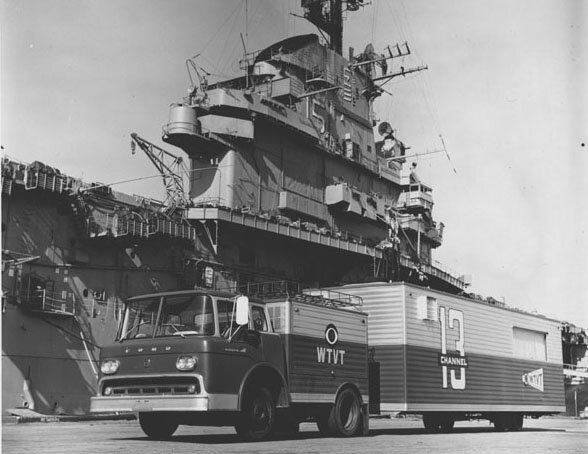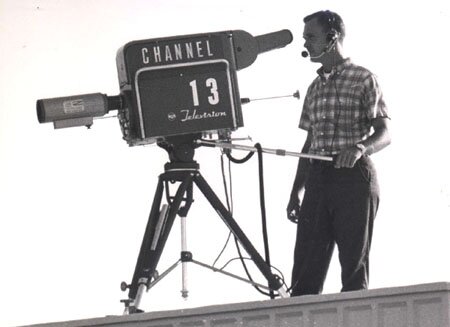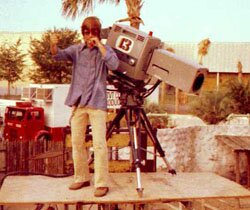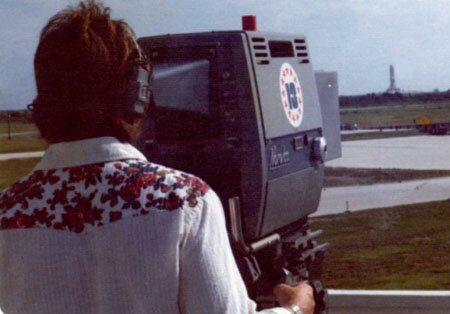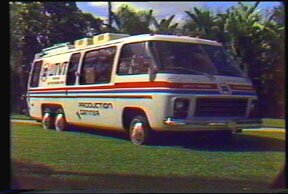|
WTVT Mobile Units |
WTVT's first mobile unit was a small truck similar in size to one of our present day UPS vehicles. Designed as a turnkey setup by RCA, television stations could purchase Model #TJ-50A, a unit ready-made with all the necessary equipment for producing remotes, including two cameras, a switcher, and a microwave transmitter to relay the signal back to the station.
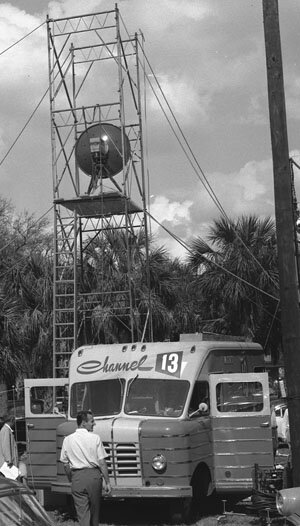 |
Remotes were limited to areas with line-of-site to the station's original single-mast tower, or there would be no reception of the microwave signal.
In 1955 Tampa, there were no buildings tall enough to make a microwave relay practical beyond certain distances. That changed in the 60's when WTVT mounted a microwave relay on Tampa's downtown First Financial Bank. In the early years, the mobile unit hauled its own antenna truss with the microwave positioned on top. Other times, the microwave dish was positioned on scaffolds or roofs, as seen at left. |
Ed Shaw, Bill Rennie, and Walter Rhoads inside Channel 13's first mobile unit.
Rennie selects different cameras from a small RCA switcher.
The mobile unit was not very practical for breaking news stories. In addition to the line-of-sight limitation, the RCA TK-30 image orthicon cameras used vacuum tubes that required a half hour to warm up and stabilize. Parades, sporting events, and remotes from the Florida State Fair were the mobile unit's main duties in the early years.
THE NEXT GENERATION
In 1959, Chief Engineer Bill Witt supervised design of a new mobile unit contained within a 30 foot-long trailer and capable of handling up to four cameras. The original mobile unit was repainted and took a new role as a backup and maintenance vehicle.
Walter Rhoads (left) supervises a remote broadcast
in the second-generation mobile unit. Note 'CBS' curtains.
The silver and red trailer contained a 12 foot long control room with switcher, monitors, and audio mixer. Adjacent was an 18 foot long engineering room with a 2" quad Ampex VTR, camera control units, microwave controls, and various pieces of support equipment.
Chief Engineer Bill Witt looks from the mobile unit's control room into engineering.
Ed Shaw is seen operating a 2" Quad VTR.
A camera and operator's seat could be mounted ahead of the driver's cab, which would certainly provide for an exciting angle as the mobile unit raced down the highway.
The rear door of the unit opened wide onto a camera platform. The platform was electrically powered and could raise equipment to the roof, where another camera platform was located. The roof camera and operator were seated on a swivel that could pan 360 degrees.
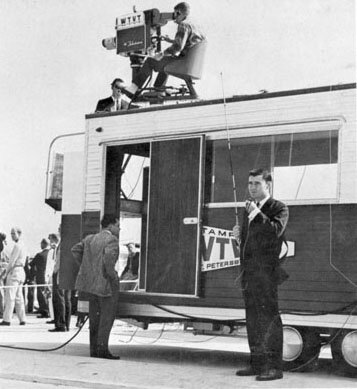 |
The mobile unit's roof swivel mount allowed camera operator Nick Stratman to pan 360 degrees. Part of the electric lift and additional camera platform is seen through the open door. Pulse news man Joe Loughlin holds the antenna for a wireless microphone. The mobile unit seen in this photo was on duty in 1960 to record opening ceremonies of the Howard Frankland Bridge. |
The term 'mobile' unit was no exaggeration...the entire unit was powered by a 25,000 watt generator located behind the driver's cab, allowing the crew to record video while actually moving. This capability came in handy during the opening ceremonies of the new Howard Frankland Bridge, when WTVT's mobile unit tracked a Cadillac carrying Florida Governor Leroy Collins, who sat in the back seat while being interviewed by Pulse anchor Joe Loughlin.
Governor LeRoy Collins and WTVT's Joe Loughlin follow the mobile unit
across the new Howard Frankland Bridge
Mobile Unit #3? Nope, WTVT just took over a tug to cover the annual Gasparilla Invasion. Two cameras feed their signals through a portable microwave (seen at the bow) in what must have been a very challenging task of maintaining a line of site to the main mobile unit.
The WTVT mobile unit was used by CBS as the pool feed for early NASA Mercury space program ocean recovery missions.
Channel 13's mobile unit is about to be lifted onto the deck
of the aircraft carrier Randolph. (1961)
The first splashdown and recovery videotaped for later playback was Gus Grissom's 1961 sub orbital flight. Taken aboard the aircraft carrier Randolph, the WTVT mobile unit was accompanied by 13's Ken Smith, Marvin Winn, Dan Boger, Ed Shaw, Jack King, Larry Eskridge, and reporter Joe Loughlin.
Cameraman Joe Wiezycki was on deck and snagged some wonderful closeups of Astronaut John Glenn as he completed a historic 1962 orbital mission. The unit was later used for recovery of Gemini 4 and 5, which marked the first time a satellite uplink was used to feed a live signal back to the United States.
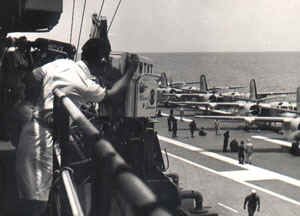
A WTVT camera scans the flattop.
Channel 13 camera setup for the St. Pete "Festival of States" parade. Note telephoto Zoomar lens and rear control near the operator's chest.
IN LIVING COLOR...
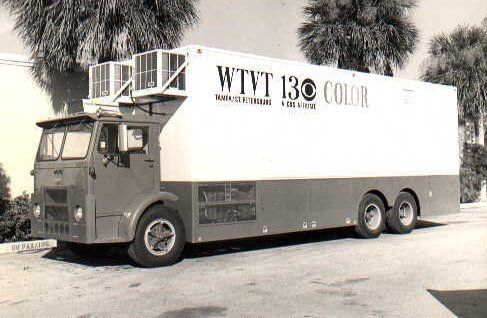
Going Places! This color mobile unit received heavy use from CBS, ABC,
and independent producers.
The black and white mobile unit required a vast engineering refit for color, so it was decided to gut the 1960 vehicle and create an entirely new one. Chief Engineer Lawton Metcalfe supervised construction of the the new color mobile unit, which was capable of using four color cameras. Although not as lengthy as the 1960 unit, the new mobile facility had the same compliment of master control room, director's room, audio room, and tape room, only much more compact and compartmentalized.
Steve Grayson on a remote at Busch Gardens (1975).
The camera is a Norelco PC-70, the workhorse of 70's television.
WTVT's 3rd mobile unit is seen in the background.
Originally, the truck was equipped with two General Electric PE-350 color cameras. Later, at the request of network clients, Norelco PC-70 cameras were installed. Although the Norelcos provided superior performance, they used 1" thick coax cable. On stadium remotes, the runs could add up to hundreds of feet of cable that had to be funneled, flown, or snaked from the truck to the camera platform. Cabling a location and then striking it later was the hardest part of all remotes, so it was a blessing for the crew when triax cable, only 1/4" thick, was introduced in the 1980's. The PC-70's were eventually replaced by Philip's LDK-5 cameras.
Chief Engineer Frank Rankel and his corps of engineers kept the
studios and mobile units humming
The WTVT remote truck eventually became one of central Florida's busiest color mobile facilities. Along with Ch. 13 cameramen and engineers, the mobile unit was used for numerous space launches at Cape Canaveral, and even appears in the motion picture "Marooned." CBS and ABC regularly used the mobile unit for regional football and baseball. KTTV, Los Angeles, rented the mobile unit and 13 crew for pre-season Dodger baseball. Other clients included "The Merv Griffin Show," "The George Jones/Tammy Wynette Show," and one of the longest running syndicated religious programs, "Day of Discovery," taped at Cypress Gardens.
All Systems Go! Live coverage from Cape Canaveral
On The Road Again...
Sleek, sassy, and loaded with 2 Hitachi cameras and 2 VTRs.
Another mobile innovation occurred in 1976 when WTVT converted a General Motors recreational vehicle into use as a remote truck. The RV was equipped with two new-generation portable Ikegami HL-33 color cameras, combining ENG style shooting with conventional production techniques. The cameras could be hand-held or mounted on tripods with complete headphone communication to the director's console. A small quad VCR, the Ampex AVR-2, was permanently installed, while a second VTR, the Ampex VR-3000, was capable of being removed from the RV and used on site. The director switched cameras from a small Grass Valley special effects generator. The new RV was used for commercial production, some 'event' news feeds, a regular church program taped on location at a local congregation, and for recording promotional spots in various bay area locales.
Engineer Bill Napier in the cab of WTVT's last mobile unit,
which was never completed.
By the late 1970s, the aging mobile unit was in constant need of repair and maintenance. Since they were permanently joined, a breakdown of the engine would also cripple the trailer. A new cab and trailer were purchased and work began to create the next generation mobile unit. But a laundry list of improvements from the networks would present the station with a stratospheric bill for updating the unit to their specifications. Management decided the cost would be too much and got out of the remote unit business. At the same time, smaller and more cost efficient production companies were opening in the Tampa Bay area. Using portable Betacam units and boutique style editing systems, these local producers lured commercial clients away from Channel 13's studio.
Studio 13 was eventually shuttered, and the new, uncompleted mobile unit was sold to Turner Broadcasting, who completed the construction.
At that point, Channel 13 was essentially out of the production business.
The mobile unit's recently installed Philips LDK-25s were moved into the studio in 1980, and equipped with permanently mounted Teleprompters.
